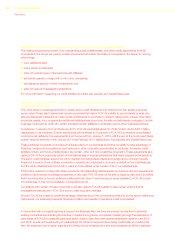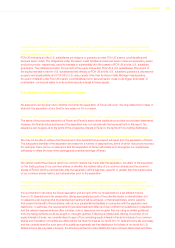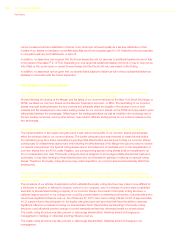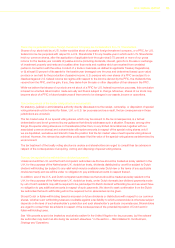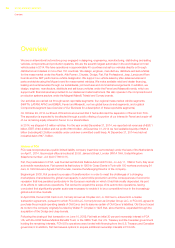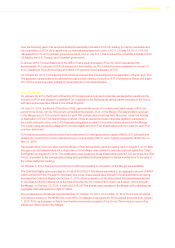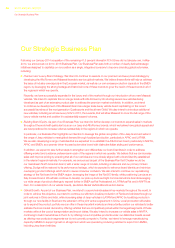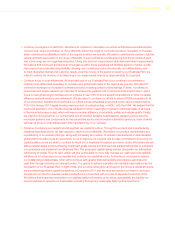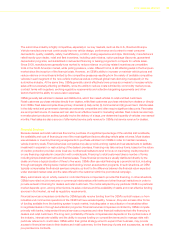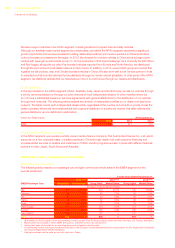Chrysler 2014 Annual Report Download - page 42
Download and view the complete annual report
Please find page 42 of the 2014 Chrysler annual report below. You can navigate through the pages in the report by either clicking on the pages listed below, or by using the keyword search tool below to find specific information within the annual report.
40 2014 | ANNUAL REPORT
Industry Overview
Industry Overview
Vehicle Segments and Descriptions
We manufacture and sell passenger cars, light trucks and light commercial vehicles covering all market segments.
Passenger cars can be divided among seven main groups, whose definition could slightly vary by region. Mini cars,
known as “A segment” vehicles in Europe and often referred to as “city cars,” are between 2.7 and 3.7 meters in
length and include three- and five-door hatchbacks. Small cars, known as “B segment” vehicles in Europe and “
sub-compacts” in the U.S., range in length from 3.7 meters to 4.4 meters and include three- and five-door
hatchbacks and sedans. Compact cars, known as “C segment” vehicles in Europe, range in length from 4.3 meters
to 4.7 meters, typically have a sedan body and mostly include three- and five-door hatchback cars. Mid-size cars,
known as “D segment” vehicles in Europe, range between 4.7 meters to 4.9 meters, typically have a sedan body or
are station wagons. Full-size cars range in length from 4.9 meters to 5.1 meters and are typically sedan cars or, in
Europe, station wagons. Minivans, also known as multi-purpose vehicles, or MPVs, typically have seating for up to
eight passengers. Utility vehicles include SUVs, which are four-wheel drive with true off-road capabilities, and cross
utility vehicles, or CUVs, which are not designed for heavy off-road use, but offer better on-road ride comfort and
handling compared to SUVs.
Light trucks may be divided between vans (also known as light commercial vehicles), which typically are used for
the transportation of goods or groups of people and have a payload capability up to 4.2 tons, and pick-up trucks,
which are light motor vehicles with an open-top rear cargo area and which range in length from 4.8 meters to 5.2
meters (in North America, the length of pick-up trucks typically ranges from 5.5 meters to 6 meters). In North America,
minivans and utility vehicles are categorized within trucks. In Europe, vans and pick-up trucks are categorized as light
commercial vehicles.
We characterize a vehicle as “new” if its vehicle platform is significantly different from the platform used in the prior
model year and/or has had a full exterior renewal. We characterize a vehicle as “significantly refreshed” if it continues
its previous vehicle platform but has extensive changes or upgrades from the prior model.
Our Industry
Designing, engineering, manufacturing, distributing and selling vehicles require significant investments in product
design, engineering, research and development, technology, tooling, machinery and equipment, facilities and
marketing in order to meet both consumer preferences and regulatory requirements. Automotive original equipment
manufacturers, or OEMs, are able to benefit from economies of scale by leveraging their investments and activities
on a global basis across brands and models. The automotive industry has also historically been highly cyclical,
and to a greater extent than many industries, is impacted by changes in the general economic environment. In
addition to having lower leverage and greater access to capital, larger OEMs that have a more diversified revenue
base across regions and products tend to be better positioned to withstand industry downturns and to benefit from
industry growth.
Most automotive OEMs produce vehicles for the mass market and some of them also produce vehicles for the luxury
market. Vehicles in the mass market are typically intended to appeal to the largest number of consumers possible.
Intense competition among manufacturers of mass market vehicles, particularly for non-premium brands, tends to
compress margins, requiring significant volumes to be profitable. As a result, success is measured in part by vehicle
unit sales relative to other automotive OEMs. Luxury vehicles on the other hand are designed to appeal to consumers
with higher levels of disposable income, and can therefore more easily achieve much higher margins. This allows
luxury vehicle OEMs to produce lower volumes, enhancing brand appeal and exclusivity, while maintaining profitability.
In 2014, 84 million automobiles were sold around the world. Although China is the largest single automotive sales
market, with approximately 18 million vehicles sold, the majority of automobile sales are still in the developed
markets, including North America, Western Europe and Japan. Growth in other emerging markets has also played an
increasingly important part in global automotive demand in recent years.




